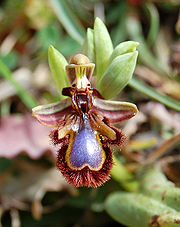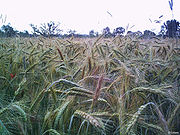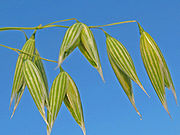
Vavilovian mimicry
Encyclopedia

Plant
Plants are living organisms belonging to the kingdom Plantae. Precise definitions of the kingdom vary, but as the term is used here, plants include familiar organisms such as trees, flowers, herbs, bushes, grasses, vines, ferns, mosses, and green algae. The group is also called green plants or...
s where a weed
Weed
A weed in a general sense is a plant that is considered by the user of the term to be a nuisance, and normally applied to unwanted plants in human-controlled settings, especially farm fields and gardens, but also lawns, parks, woods, and other areas. More specifically, the term is often used to...
comes to share one or more characteristics with a domesticated plant
Crop (agriculture)
A crop is a non-animal species or variety that is grown to be harvested as food, livestock fodder, fuel or for any other economic purpose. Major world crops include maize , wheat, rice, soybeans, hay, potatoes and cotton. While the term "crop" most commonly refers to plants, it can also include...
through generations of artificial selection
Artificial selection
Artificial selection describes intentional breeding for certain traits, or combination of traits. The term was utilized by Charles Darwin in contrast to natural selection, in which the differential reproduction of organisms with certain traits is attributed to improved survival or reproductive...
. It is named after Nikolai Vavilov
Nikolai Vavilov
Nikolai Ivanovich Vavilov was a prominent Russian and Soviet botanist and geneticist best known for having identified the centres of origin of cultivated plants...
, a prominent Russian plant
Botany
Botany, plant science, or plant biology is a branch of biology that involves the scientific study of plant life. Traditionally, botany also included the study of fungi, algae and viruses...
geneticist
Geneticist
A geneticist is a biologist who studies genetics, the science of genes, heredity, and variation of organisms. A geneticist can be employed as a researcher or lecturer. Some geneticists perform experiments and analyze data to interpret the inheritance of skills. A geneticist is also a Consultant or...
who identified the centres of origin of cultivated plants. Selection against the weed may occur by killing a young or adult weed, separating its seeds from those of the crop (winnowing), or both. This has been done manually since Neolithic
Neolithic
The Neolithic Age, Era, or Period, or New Stone Age, was a period in the development of human technology, beginning about 9500 BC in some parts of the Middle East, and later in other parts of the world. It is traditionally considered as the last part of the Stone Age...
times, and in more recent years by agricultural machinery
Agricultural machinery
Agricultural machinery is machinery used in the operation of an agricultural area or farm.-Hand tools:The first person to turn from the hunting and gathering lifestyle to farming probably did so by using his bare hands, and perhaps some sticks or stones. Tools such as knives, scythes, and wooden...
.
Vavilovian mimicry is a good illustration of unintentional selection
Selection
In the context of evolution, certain traits or alleles of genes segregating within a population may be subject to selection. Under selection, individuals with advantageous or "adaptive" traits tend to be more successful than their peers reproductively—meaning they contribute more offspring to the...
by humans. Although the human selective agents might be conscious of their impact on the local weed gene pool
Gene pool
In population genetics, a gene pool is the complete set of unique alleles in a species or population.- Description :A large gene pool indicates extensive genetic diversity, which is associated with robust populations that can survive bouts of intense selection...
, such effects go against the goals of those growing crops. Weeders do not want to select weeds that are increasingly similar to the cultivated plant, yet the only other option is to let the weeds grow and compete
Competition (biology)
Competition is an interaction between organisms or species, in which the fitness of one is lowered by the presence of another. Limited supply of at least one resource used by both is required. Competition both within and between species is an important topic in ecology, especially community ecology...
with crops for sunlight
Sunlight
Sunlight, in the broad sense, is the total frequency spectrum of electromagnetic radiation given off by the Sun. On Earth, sunlight is filtered through the Earth's atmosphere, and solar radiation is obvious as daylight when the Sun is above the horizon.When the direct solar radiation is not blocked...
and nutrients
Plant nutrition
'Plant Nutrition is the study of the chemical elements that are necessary for growth. In 1972, E. Epstein defined 2 criteria for an element to be essential for plant growth:# in its absence the plant is unable to complete a normal life cycle or...
. Similar situations include antibiotic resistance
Antibiotic resistance
Antibiotic resistance is a type of drug resistance where a microorganism is able to survive exposure to an antibiotic. While a spontaneous or induced genetic mutation in bacteria may confer resistance to antimicrobial drugs, genes that confer resistance can be transferred between bacteria in a...
and, of similar nature to crop mimicry, herbicide resistance. This can be contrasted with other forms of artificial selection that do tend toward a favorable outcome, such as selective breeding
Selective breeding
Selective breeding is the process of breeding plants and animals for particular genetic traits. Typically, strains that are selectively bred are domesticated, and the breeding is sometimes done by a professional breeder. Bred animals are known as breeds, while bred plants are known as varieties,...
. Having acquired many desirable qualities by being subjected to similar selective pressures, Vavilovian mimics may eventually be domesticated themselves. Vavilov called these weeds-become-crops secondary crops.
Classification and comparisons

Aggressive mimicry
Aggressive mimicry is a form of mimicry where predators, parasites or parasitoids share similar signals with a harmless model, allowing them to avoid being correctly identified by their prey or host...
(parasitic
Parasitic plant
A parasitic plant is one that derives some or all of its sustenance from another plant. About 4,100 species in approximately 19 families of flowering plants are known. Parasitic plants have a modified root, the haustorium, that penetrates the host plant and connects to the xylem, phloem, or...
) and, in the case of secondary crops, mutualistic. It is a form of disjunct mimicry with the model agreeable to the dupe. In disjunct mimicry complexes, three different species are involved as model, mimic and dupe—the weed, mimicking a protected crop model, with humans as signal receivers. Vavilovian mimicry bears considerable similarity to Batesian mimicry
Batesian mimicry
Batesian mimicry is a form of mimicry typified by a situation where a harmless species has evolved to imitate the warning signals of a harmful species directed at a common predator...
(where a harmless organism mimics a harmful species) in that the weed does not share the properties that give the model its protection, and both the model and the dupe (in this case people) are negatively affected by it. There are some key differences, though; in Batesian mimicry the model and signal receiver are enemies (the predator would eat the protected species if it could), whereas here the crop and its human growers are in a mutualistic relationship: the crop benefits from being dispersed and protected by people, despite being eaten by them. In fact, the crop's only 'protection' relevant here is its usefulness to humans. Secondly, the weed is not eaten, but simply killed (either directly or by not planting the seed). The only motivation for killing the weed is its effect on crop yields. Farmers would prefer to have no weeds at all, but a predator would die if it had no prey to eat, even if they might be difficult to identify. Finally, there is no known equivalent of Vavilovian mimicry in ecosystems unaltered by humans.
Many other cases of mimicry in plants are also known. In one class, flowers emit signals which cause insects to copulate
Pseudocopulation
Pseudocopulation describes behaviors similar to copulation that serve a reproductive function for one or both participants but do not involve actual sexual union between the individuals. It is most generally applied to a pollinator attempting to copulate with a flower. Some flowers mimic a...
with them, effecting pollination
Pollination
Pollination is the process by which pollen is transferred in plants, thereby enabling fertilisation and sexual reproduction. Pollen grains transport the male gametes to where the female gamete are contained within the carpel; in gymnosperms the pollen is directly applied to the ovule itself...
in the process. They may also resemble other organisms in defense, such as passion flower
Passion flower
Passiflora, known also as the passion flowers or passion vines, is a genus of about 500 species of flowering plants, the namesakes of the family Passifloraceae. They are mostly vines, with some being shrubs, and a few species being herbaceous. For information about the fruit of the passiflora...
leaves mimicking the eggs of butterflies, which deters them from laying.
Delbert Wiens has suggested secondary crops cannot be classified as mimics because they result from artificial as opposed to natural selection
Natural selection
Natural selection is the nonrandom process by which biologic traits become either more or less common in a population as a function of differential reproduction of their bearers. It is a key mechanism of evolution....
, and because the selective agent is a machine
Machine
A machine manages power to accomplish a task, examples include, a mechanical system, a computing system, an electronic system, and a molecular machine. In common usage, the meaning is that of a device having parts that perform or assist in performing any type of work...
. On this first point, Georges Pasteur points out that "indirect artificial selection" is involuntary and thus no different from natural selection. The signal receiver being an inanimate object certainly deviates from the normal case of a dupe perceiving
Perception
Perception is the process of attaining awareness or understanding of the environment by organizing and interpreting sensory information. All perception involves signals in the nervous system, which in turn result from physical stimulation of the sense organs...
the signal, but the result is no different from that of manual selection that has been occurring since the Neolithic Revolution
Neolithic Revolution
The Neolithic Revolution was the first agricultural revolution. It was the transition from hunting and gathering to agriculture and settlement. Archaeological data indicates that various forms of plants and animal domestication evolved independently in 6 separate locations worldwide circa...
.
Examples
One case of Vavilovian mimicry is the gold-of-pleasure or false flax (Camelina sativa linicola), which looks much like the flaxFlax
Flax is a member of the genus Linum in the family Linaceae. It is native to the region extending from the eastern Mediterranean to India and was probably first domesticated in the Fertile Crescent...
plant Linum usitatissimum, and occurs with it in the field. The gold-of-pleasure is a descendant of Camelina gabrata, a wild species; its subspecific name
Subspecies
Subspecies in biological classification, is either a taxonomic rank subordinate to species, ora taxonomic unit in that rank . A subspecies cannot be recognized in isolation: a species will either be recognized as having no subspecies at all or two or more, never just one...
linicola means "the one that lives with flax". Weeding of the adult plant is impractical; instead they are separated based on properties of the seed
Seed
A seed is a small embryonic plant enclosed in a covering called the seed coat, usually with some stored food. It is the product of the ripened ovule of gymnosperm and angiosperm plants which occurs after fertilization and some growth within the mother plant...
. This is done by a winnowing machine, which in this case acts as an inanimate signal receiver. Seeds that are thrown the same distance as flax seeds have thus been selected for, making it near impossible to separate the seeds of these two species.


Rye
Rye is a grass grown extensively as a grain and as a forage crop. It is a member of the wheat tribe and is closely related to barley and wheat. Rye grain is used for flour, rye bread, rye beer, some whiskeys, some vodkas, and animal fodder...
(Secale cereale), a grass
Grass
Grasses, or more technically graminoids, are monocotyledonous, usually herbaceous plants with narrow leaves growing from the base. They include the "true grasses", of the Poaceae family, as well as the sedges and the rushes . The true grasses include cereals, bamboo and the grasses of lawns ...
which is derived from wild rye (Secale montanum), a widely distributed Mediterranean species. Rye was originally just a weed growing with wheat
Wheat
Wheat is a cereal grain, originally from the Levant region of the Near East, but now cultivated worldwide. In 2007 world production of wheat was 607 million tons, making it the third most-produced cereal after maize and rice...
and barley
Barley
Barley is a major cereal grain, a member of the grass family. It serves as a major animal fodder, as a base malt for beer and certain distilled beverages, and as a component of various health foods...
, but came under similar selective pressures to the crops. Like wheat, it came to have larger seeds and more rigid spindles to which the seeds are attached. However, wheat is an annual plant
Annual plant
An annual plant is a plant that usually germinates, flowers, and dies in a year or season. True annuals will only live longer than a year if they are prevented from setting seed...
, while wild rye is a perennial
Perennial plant
A perennial plant or simply perennial is a plant that lives for more than two years. The term is often used to differentiate a plant from shorter lived annuals and biennials. The term is sometimes misused by commercial gardeners or horticulturalists to describe only herbaceous perennials...
. At the end of each growing season wheat produces seeds, while wild rye does not and is thus destroyed as the post-harvest soil is tilled. However, there are occasional mutant
Mutant
In biology and especially genetics, a mutant is an individual, organism, or new genetic character, arising or resulting from an instance of mutation, which is a base-pair sequence change within the DNA of a gene or chromosome of an organism resulting in the creation of a new character or trait not...
s that do set seed. These have been protected from destruction, and rye has thus evolved to become an annual plant.
Rye is a more hardy plant than wheat, surviving in harsher conditions. Having become preadapted
Preadaptation
In evolutionary biology, preadaptation describes a situation where a species evolves to use a preexisting structure or trait inherited from an ancestor for a potentially unrelated function...
as a crop through wheat mimicry, rye was then positioned to become a cultivated plant in areas where soil and climatic conditions favored its production, such as mountainous terrain.
This fate is shared by oats
OATS
OATS - Open Source Assistive Technology Software - is a source code repository or "forge" for assistive technology software. It was launched in 2006 with the goal to provide a one-stop “shop” for end users, clinicians and open-source developers to promote and develop open source assistive...
(Avena), which also tolerate poorer conditions, and like rye, grow as a weed alongside wheat and barley. Derived from a wild species (Avena sterilis
Avena sterilis
Avena sterilis is a species of grass weed, and its seeds are edible.-External links:***...
), it has thus come to be a crop in its own right. Once again paralleling wheat, rye and other cereals, oats have developed tough spindles which prevent seeds from easily dropping off, and other characters which also help in natural dispersal
Biological dispersal
Biological dispersal refers to species movement away from an existing population or away from the parent organism. Through simply moving from one habitat patch to another, the dispersal of an individual has consequences not only for individual fitness, but also for population dynamics, population...
have become vestigial, including the awns which allow them to self bury.
The flax-dodder (Cuscuta epilinum) is a creeper than grows around flax and linseed plants. Much like the other cases, its seeds have become larger. A mutant double-seeded variety has become prevalent, as seed size has once again been the character upon which selection has acted.
Selection can also occur on the vegetative stage, through hand weeding. Weeding often takes place when the crop plant is very young, and most vulnerable. Echinochloa oryzoides
Echinochloa oryzoides
Echinochloa oryzoides is a species of grass known by the common name early barnyard grass. Its origin is not certain but it may be Eurasia. The grass is known in rice-growing areas of the world as a weed of rice paddies.-External links:***...
, a species of grass which is found as a weed in rice
Rice
Rice is the seed of the monocot plants Oryza sativa or Oryza glaberrima . As a cereal grain, it is the most important staple food for a large part of the world's human population, especially in East Asia, Southeast Asia, South Asia, the Middle East, and the West Indies...
(Oryza sativa) fields, looks similar to rice and its seeds are often mixed in rice and difficult to separate. This close similarity was enhanced by the weeding process which is a selective force that increases the similarity of the weed in each subsequent generation.

